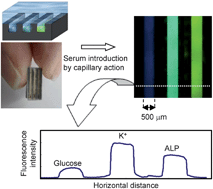To enhance sensitivity and facilitate easy sample introduction into a combinable poly(dimethylsiloxane) (PDMS) capillary (CPC) sensor array, PDMS was modified in bulk and on its surface to prepare “black” PDMS coated with a silver layer and self-assembled monolayer (SAM). India ink, a traditional Japanese black ink, was added to the PDMS pre-polymer for bulk modification. The surface was modified by a silver mirror reaction followed by SAM formation using cysteine. These modifications enhanced the fluorescence signals by reflecting them from the surface and reducing background interference. A decrease in the water contact angle led to enhanced sensitivity and easy sample introduction. Furthermore, a CPC sensor array for multiplex detection of serum sample components was prepared that could quantify the analytes glucose, potassium, and alkaline phosphatase (ALP). When serum samples were introduced by capillary action, the CPC sensor array showed fluorescence responses for each analyte and successfully identified the components with elevated concentrations in the serum samples.

You have access to this article
 Please wait while we load your content...
Something went wrong. Try again?
Please wait while we load your content...
Something went wrong. Try again?


 Please wait while we load your content...
Please wait while we load your content...